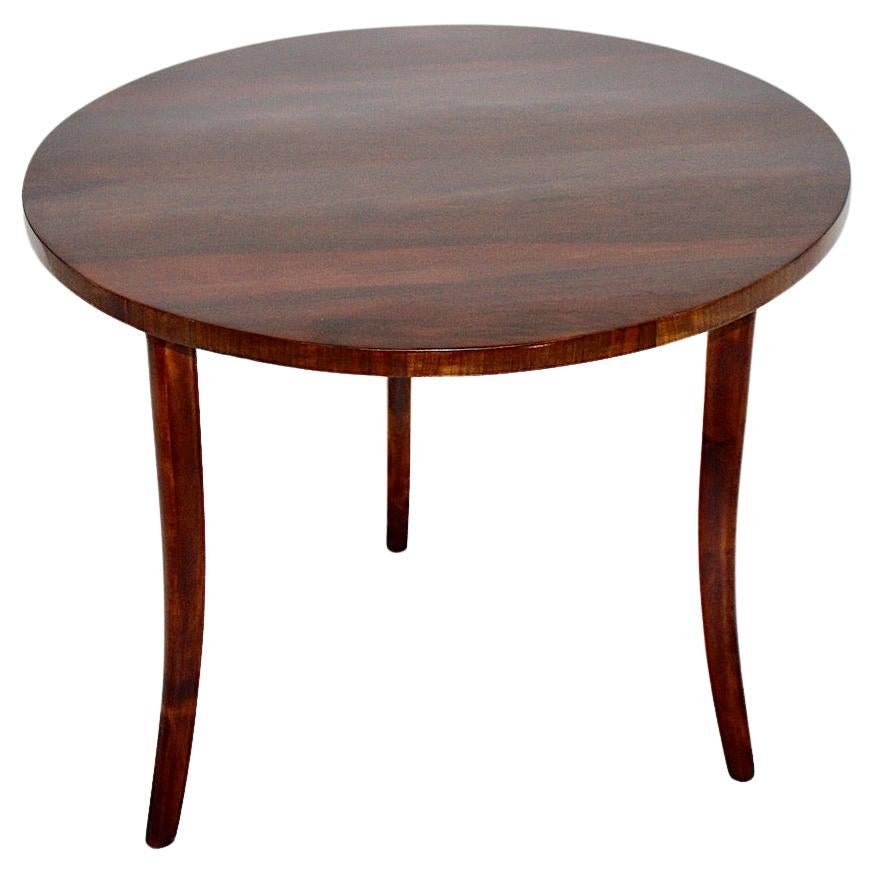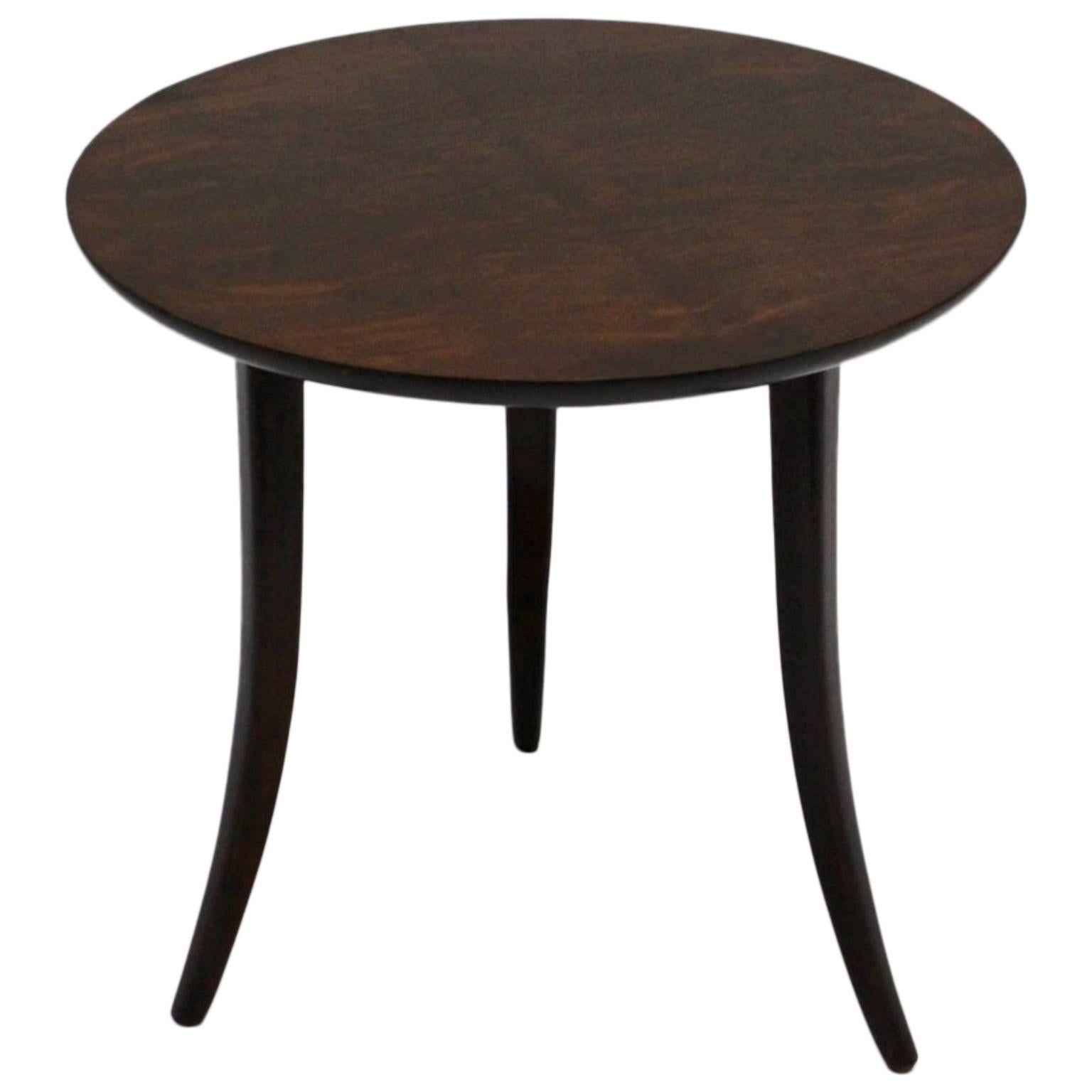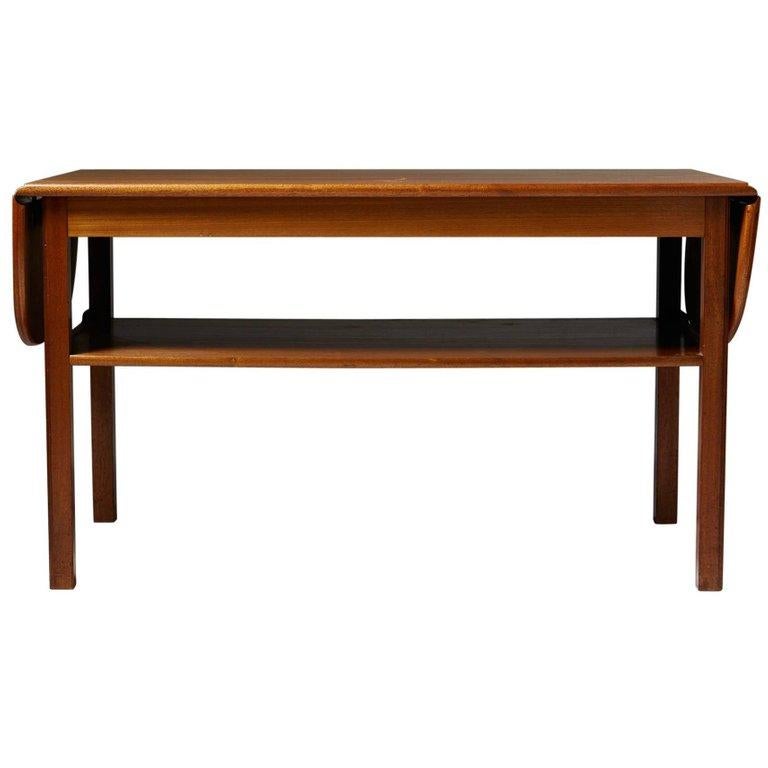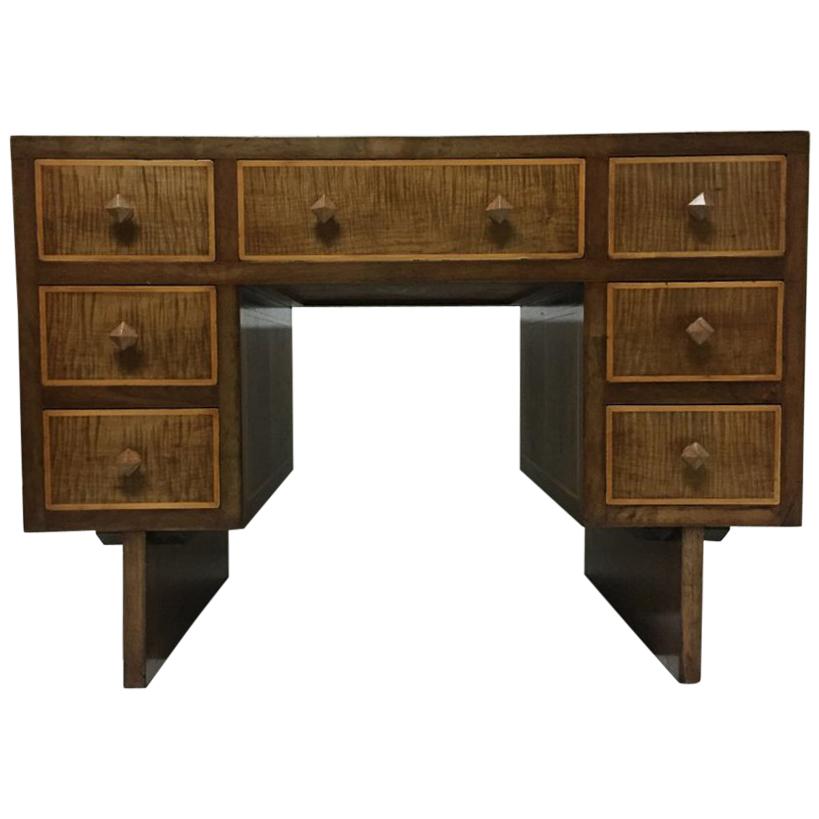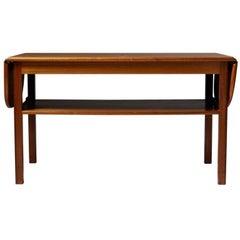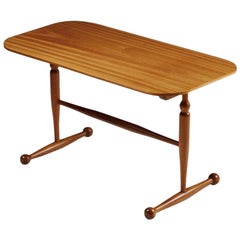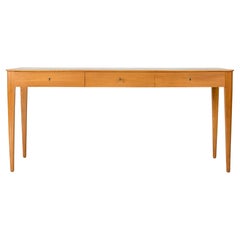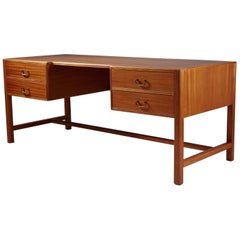
Desk Designed by Josef Frank for Haus Und Garten, Austria, 1932
View Similar Items
Desk Designed by Josef Frank for Haus Und Garten, Austria, 1932
About the Item
- Creator:Josef Frank (Designer)
- Dimensions:Height: 28.75 in (73 cm)Width: 70.87 in (180 cm)Depth: 28.35 in (72 cm)
- Style:Scandinavian Modern (Of the Period)
- Materials and Techniques:
- Place of Origin:
- Period:
- Date of Manufacture:1932
- Condition:
- Seller Location:Stockholm, SE
- Reference Number:1stDibs: LU100669602631
Josef Frank
Austrian architect and furniture and fabric designer Josef Frank was a leading voice for a gentle, humane modernism. His advocacy of warm, comfortable, eclectically styled environments was highly influential in his adopted country of Sweden, and it’s now widely regarded as a harbinger of the backlash against doctrinaire modernism and the embrace of the homespun that occurred in the late 1960s.
The son of a successful Viennese textile manufacturer, Frank studied architecture at Vienna University of Technology, graduating in 1910. From the first years of his practice, he marched counter to the orderly, symmetrical architectural layouts and decors prescribed by contemporaries such as Adolf Loos.
Frank drafted rooms of varying shapes and called for flexible interior-design arrangements. His furniture pieces are light and easy to move — and his chairs are always made of wood, most often with lushly curved steam-bent arms and slatted backs. Frank openly loathed the tubular steel furnishings and “machine for living” aesthetic promoted by Le Corbusier and Ludwig Mies van der Rohe and other Bauhaus principals. “The home must not be a mere efficient machine,” Frank once said. “It must offer comfort, rest and coziness…. There are no puritan principles in good interior decoration.”
Frank — who was Jewish — sensed the dire implications of the rise of Nazism in Germany and Austria, and in 1933 he moved to Stockholm with his Swedish wife, Anna. He became the design chief for the furnishings maker Svenskt Tenn and found a perfect match culturally for his brand of simple, relaxed and bright creations. Like many modernists — notably Charles and Ray Eames and Alexander Girard — Frank had a deep love of folk art, which influenced his designs for a wide array of colorful, richly patterned upholstery fabrics, many based on the classic “Tree of Life” motif.
In all his designs, Frank took inspiration from a broad variety of sources. In his furniture, one can discern traces of Asian patterns, Rococo, Italian Renaissance, Scandinavian handicrafts and even Chippendale pieces. As such, the work of Frank — the friendly modernist — is at home in any type of décor.
Find vintage Josef Frank pillows, armchairs, floor lamps and other furniture on 1stDibs.
- Floor Lamp Model 1842 Designed by Josef Frank for Svenskt Tenn, Sweden, 1932By Josef FrankLocated in Stockholm, SEFloor lamp model 1842 designed by Josef Frank for Svenskt Tenn, Sweden, 1932. Brass. Measures: H: 102.5 cm W: 36 cm Shade diameter: 24 cm Base diamete...Category
Mid-20th Century Swedish Mid-Century Modern Floor Lamps
MaterialsBrass
- Occasional Table Designed by Josef Frank for Svenskt Tenn, Sweden, 1950sBy Josef FrankLocated in Stockholm, SEOccasional table designed by Josef Frank for Svenskt Tenn, Sweden, 1950s. Mahogany. Measurements: H: 60 cm/ 23 1/2'' Length when extened: 104 cm/ 3' 5'' D: 54 cm/ 21 1/2'' Jose...Category
Vintage 1950s Swedish Scandinavian Modern Side Tables
MaterialsMahogany
- Occasional Table Designed by Josef Frank for Svenskt Tenn, Sweden, 1950sBy Josef FrankLocated in Stockholm, SEOccasional table designed by Josef Frank for Svenskt Tenn, Sweden. 1950s. Mahogany. H: 45 cm L: 80 cm D: 40 cm Josef Frank was a true European, he was also a pioneer of what would become classic 20th century Swedish design and the “Scandinavian Design Style”. Austrian- born Frank started his design career as an architect after having trained at the Technische Hochschule in Vienna between 1903 and 1910. After his training he went on to teach at Kunstgewerbeschule (The Viennese School of Arts and crafts) where he developed and espoused the new school of modernist thinking towards Architecture and Design that was coming to fruition in Vienna at the time. He also went on to lead the Vienna Werkbund throughout the 1920s. This was a truly progressive group of Architects and Designers who set about improving the daily lives of Austrian people through modernist design and architecture in partnership with Arts and Crafts ideals and construction. Frank’s leadership of the Werkbund had already cemented his place at the forefront of European design. Frank’s time in Vienna was typified by his design for the “Die Wohnung” exhibition of the Deutscher Werkbund in Stuttgart, 1927 where he exhibited along side his contemporaries at the forefront of design, such as the likes of Le Corbusier and Walter Gropius. Here he showed a specially designed pair of flat-roofed reinforced concrete houses in what is now seen as a typical modernist style. What separated Frank’s house from the other 32 houses of the exhibition was the interior and furniture inside the building. It was described as “Neo-Classical” and filled with an eclectic mix of period pieces, modern design and pieces designed by Frank himself that seemed to cross the two worlds. This was a complete opposite direction to that which his fellow Architects were travelling in with their pared back and angular aesthetics. Frank said of his own work: “The house is not a work of art, simply a place where one lives,” and by this reasoning Frank rejected the regimental mechanisation of the living space that his contemporaries believed in, instead he set about creating congenial and spontaneous interiors. Frank’s practice saw him placing the bright colours and the soft forms of nature back into the furnishings and interiors that he thought modernism sorely mist. Frank, along with Oskar Walch set up Haus und Garten in Vienna in 1925. This was Frank’s first commercial foray into furniture and home furnishings and the company went on to become the most influential furnishing house in Vienna with a riotous depth of colour and interesting shapes becoming the trademark of their design. However this success was to come to an end with rise of Nazism in Vienna in the early 1930’s. Frank was Jewish, and he and his wife Anna decided they would leave Vienna for her motherland: Sweden, in 1933. Frank continued to design for Haus and Garten, visiting Vienna occasionally and designing the pieces that would continue to be the company’s best...Category
Vintage 1950s Swedish Scandinavian Modern Tables
MaterialsMahogany
- Desk designed by Alvar Andersson for Hyresgästföreningen, retailed by G.A. BergBy Gustaf Axel BergLocated in Stockholm, SEDesk designed by Alvar Andersson for Hyresgästföreningen, retailed by G.A. Berg Sweden. 1930s. Black lacquered birch, elm and pewter inlay. Dimensions: H: 75 cm/ 29 1/2'' L: 150 cm...Category
Vintage 1930s Swedish Scandinavian Modern Desks and Writing Tables
MaterialsElm, Birch
- Occasional Table Model 2168 Designed by Josef Frank for Svenskt TennBy Josef FrankLocated in Stockholm, SEOccasional table model 2168 designed by Josef Frank for Svenskt Tenn, Sweden. 1950s. Walnut and marble. Josef Frank’s occasional table “model 2168” is one of his rarer models. Its beautifully carved, turned legs...Category
Mid-20th Century Swedish Mid-Century Modern Tables
MaterialsMarble
- Table lamp model 2552 designed by Josef Frank for Svenskt Tenn, Sweden. 1950sBy Josef FrankLocated in Stockholm, SEBrass. Table Lamp Model 2552 Designed by Josef Frank for Svenskt Tenn, Sweden, 1950s Measures: H 49.5 cm Josef Frank was a true European, he was also a pioneer of what would become classic 20th century Swedish design and the “Scandinavian Design Style”. Austrian- born Frank started his design career as an architect after having trained at the Technische Hochschule in Vienna between 1903 and 1910. After his training he went on to teach at Kunstgewerbeschule (The Viennese School of Arts and crafts) where he developed and espoused the new school of modernist thinking towards Architecture and Design that was coming to fruition in Vienna at the time. He also went on to lead the Vienna Werkbund throughout the 1920s. This was a truly progressive group of Architects and Designers who set about improving the daily lives of Austrian people through modernist design and architecture in partnership with Arts and Crafts ideals and construction. Frank’s leadership of the Werkbund had already cemented his place at the forefront of European design. Frank’s time in Vienna was typified by his design for the “Die Wohnung” exhibition of the Deutscher Werkbund in Stuttgart, 1927 where he exhibited along side his contemporaries at the forefront of design, such as the likes of Le Corbusier and Walter Gropius. Here he showed a specially designed pair of flat-roofed reinforced concrete houses in what is now seen as a typical modernist style. What separated Frank’s house from the other 32 houses of the exhibition was the interior and furniture inside the building. It was described as “Neo-Classical” and filled with an eclectic mix of period pieces, modern design and pieces designed by Frank himself that seemed to cross the two worlds. This was a complete opposite direction to that which his fellow Architects were travelling in with their pared back and angular aesthetics. Frank said of his own work: “The house is not a work of art, simply a place where one lives,” and by this reasoning Frank rejected the regimental mechanisation of the living space that his contemporaries believed in, instead he set about creating congenial and spontaneous interiors. Frank’s practice saw him placing the bright colours and the soft forms of nature back into the furnishings and interiors that he thought modernism sorely mist. Frank, along with Oskar Walch set up Haus und Garten in Vienna in 1925. This was Frank’s first commercial foray into furniture and home furnishings and the company went on to become the most influential furnishing house in Vienna with a riotous depth of colour and interesting shapes becoming the trademark of their design. However this success was to come to an end with rise of Nazism in Vienna in the early 1930’s. Frank was Jewish, and he and his wife Anna decided they would leave Vienna for her motherland: Sweden, in 1933. Frank continued to design for Haus and Garten, visiting Vienna occasionally and designing the pieces that would continue to be the company’s best...Category
Vintage 1950s Swedish Scandinavian Modern Table Lamps
MaterialsBrass
- Josef Frank Art Deco Walnut Circular Side Table Haus & Garten circa 1928 AustriaBy Josef FrankLocated in Vienna, ATArt Deco vintage coffee table or side table by Josef Frank for Haus & Garten circa 1928 Austria. A stunning and sleek Josef Frank coffee table from the Viennese Art Deco period circa...Category
Vintage 1920s Austrian Art Deco Coffee and Cocktail Tables
MaterialsWalnut, Spruce
- Midcentury Elm Desk by Josef Frank, Svenskt Tenn, Sweden, 1950sBy Josef Frank, Svenskt TennLocated in Stockholm, SEBeautiful desk by Josef Frank, made from elm with striking woodgrain. Clean lines and subtly rounded forms, a timeless piece.Category
Vintage 1950s Swedish Scandinavian Modern Desks and Writing Tables
MaterialsElm
- Josef Frank Art Deco Era Round Walnut Side Table for Haus & Garten c 1926 ViennaBy Josef FrankLocated in Vienna, ATArt Deco circular charming three-legged side table from walnut by Josef Frank for Haus & Garten, Vienna, circa 1926. The side table was made of solid walnut feet and walnut veneer. T...Category
Vintage 1920s Austrian Art Deco Side Tables
MaterialsWalnut, Spruce
- Art Deco Vintage Walnut Side Table by Josef Frank Haus and Garten Vienna c 1925By Josef FrankLocated in Vienna, ATArt Deco vintage walnut side table / coffee table by Josef Frank for Haus & Garten, circa 1925 Vienna, shows a top with beautiful walnut burl...Category
Vintage 1920s Austrian Art Deco Coffee and Cocktail Tables
MaterialsBeech, Spruce, Walnut
- Art Deco Vintage Circular Coffee Table Josef Frank Haus & Garten c 1925 ViennaLocated in Vienna, ATArt Deco vintage circular coffee table or side table with an ornament top by Josef Frank for Haus & Garten circa 1925 Vienna. An amazing...Category
Vintage 1920s Austrian Art Deco Coffee and Cocktail Tables
MaterialsAsh, Beech, Walnut
- Antique Bentwood Desk by Jacob and Josef Kohn Austria c.1910By Jacob & Josef KohnLocated in London, GBA beautiful and extremely rare desk made by the high end manufacturers Jacob and Josef Kohn. This was most likely designed by Josef Frank, it was made in Austria and dates from around 1900-1910 period. The original Jacob and Josef Kohn label is seen below the top, and this has all the hallmarks of their quality pieces. It is beautifully made with a bentwood frame, solid beach desk...Category
Vintage 1910s Austrian Desks and Writing Tables
MaterialsLeather, Beech, Bentwood
